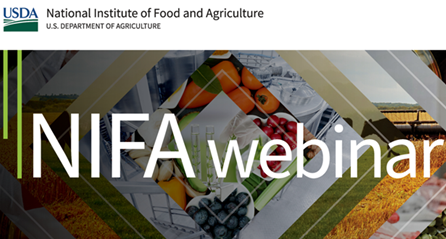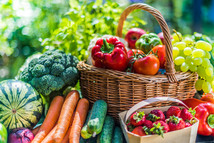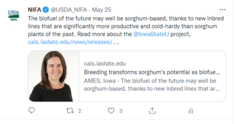
Cookbook App a Recipe for Success
University of Southern California researchers decided to develop a mobile app that allows users to select the ingredients they have available and create a virtual cookbook of healthy recipes. The idea came to fruition with a five-year, $1.3 million Agriculture and Food Research Initiative award from NIFA in 2012. Informed by pantry clients, chefs and a culinary school, the team developed VeggieBook, an app with more than 250 vegetable-based recipes, along with nearly 80 Secrets to Better Eating – general tips about more nutritious eating and strategies for budget-wise food shopping.
VeggieBook graphic, courtesy of VeggieBook.
|

Cool as a Cucumber
One of the most versatile vegetables you can eat is the cucumber. While a great addition atop any garden or chef salad, the cucumber is also a popular ingredient when tossed with a little vinegar and seasoning and paired with other veggies like onions and olives. It’s great in a smoothie, paired with fresh melon or even used in fragrances. It’s equally versatile in its presentation. Whether sliced thin or longways, spiraled into thin strips or used as a roll-up or “boat” to hold other ingredients, the cucumber is as unique as it is delicious. NIFA understands the importance of this vital vegetable and supports research that is leading to stronger, healthier, more disease-resistant cucumber varieties.
National Salad Month graphic, courtesy of NIFA.
|

Holy Cow! It’s World Milk Day!
June 1 marks World Milk Day and the kickoff of National Dairy Month. According to the USDA’s Economic Research Service, in 2020 more than 9 million dairy cows produced 223.2 billion pounds of milk in the United States. On World Milk Day, we’re highlighting the work of Land-grant Universities conducting dairy research and Extension education with support from NIFA.
World Milk Day graphic, courtesy of NIFA.
|

Memorial Day: NIFA Supports U.S. Military Community
Each year on the last Monday of May, Americans honor U.S. Armed Forces members who have died in the performance of their service to our country. Memorial Day is a federal holiday to remember our fallen heroes. It’s also an appropriate time to reflect on how we can assist our military community every day. NIFA supports military members, veterans and military families through a variety of programs and services.
Memorial Day graphic, courtesy of NIFA.
|

Research Strengthens Tools for Wildfire Management, Adaptation and Recovery
Wildfires in the U.S. are getting larger, lasting longer, and causing greater amounts of damage to communities across the country. According to the USDA, more than 10 million acres have burned nationwide since 2015, causing billions of dollars in losses. For farmers, ranchers and rural communities, the effects of wildfire are both immediate and long-term, with devastating impacts to both the environment and the economy. Every year, NIFA funds projects that reduce the risk of destructive wildfires and restore forest health while also developing novel approaches for growers and rural communities to adapt to the increasing threat.
National Wildfire Awareness Month graphic, courtesy of NIFA.
|

Mint Your Own Garden Gold
Reduce. Reuse. Recycle. Compost. Composting is the act of collecting and storing plant material so it can decay and be added to soil to improve its quality. If you are ready to begin composting or are searching for ways to up your composting game, look for resources from Cooperative Extension in your state. With support from NIFA and based at the nation’s Land-grant Institutions, Cooperative Extension offers a wealth of resources to help you turn waste into garden gold.
Composting Day graphic, courtesy of NIFA.
|

We are hiring! NIFA recruits a diverse group of talented, creative, motivated professionals who are invested in shaping the future of food and agricultural science. We offer a variety of benefits and services to our employees that focus on work-life balance, career enhancement, and health and well-being.
NIFA has career opportunities in a variety of scientific disciplines covering engineering, food science, forestry, education, animal and crop sciences, and many other agriculture-related disciplines. NIFA job openings are listed on USAJobs.gov. Current NIFA job openings are for Kansas City, Missouri, or a location negotiable after selection, unless otherwise noted below.
Associate Director for Operations (ES-00)
Closing Date: June 23
View the job announcement.
Career Opportunities graphic, courtesy of NIFA.
|

Attention Extension
Agriculture Secretary Tom Vilsack has announced more support, resources and new rules that will strengthen the American food supply chain, promote fair and competitive agricultural markets, prevent abuse of farmers by poultry processors, and make prices fairer for farmers and American consumers. These actions build on President Biden’s historic whole-of-government effort to promote competition in the American economy and fulfill key pillars of the Meat and Poultry Supply Chain Action Plan launched in January by President Biden, Secretary Vilsack and Attorney General Merrick Garland. These actions combat market dominance by a small number of major meat and poultry processors in key markets, where excessive concentration and control has led to lower prices paid to producers and higher prices paid by consumers.
USDA graphic symbol.
|

Regional Listening Sessions Announced for White House Conference on Hunger, Nutrition and Health
The White House has announced virtual, regional listening sessions for you to share your ideas and experiences with hunger and diet-related diseases in your communities. The listening sessions are being held in advance of the forthcoming White House Conference on Hunger, Nutrition and Health to be held in September. The conference and the listening sessions are part of the goal of the Biden-Harris Administration to end hunger by 2030 and reduce the incidence of diet-related diseases in the U.S.
Join the White House Conference on Hunger, Nutrition and Health graphic,
courtesy of USDA.
|
USDA to Provide Approximately $6 Billion to Commodity and Specialty Crop Producers Impacted by 2020 and 2021 Natural Disasters
USDA has announced that commodity and specialty crop producers impacted by natural disaster events in 2020 and 2021 will soon begin receiving emergency relief payments totaling approximately $6 billion through the Farm Service Agency’s new Emergency Relief Program to offset crop yield and value losses.

Simple, Inexpensive Diagnostic Technology to Combat Global Threat of African Swine Fever
While the attention of public health authorities has been riveted on the COVID-19 pandemic, caused by the novel coronavirus SARS-CoV-2, many other viruses have been stealthily circling the globe, causing serious disease and death in humans and other animals. One such pathogen is a virus responsible for African Swine Fever. The highly contagious, often lethal disease has devastated swine populations around the world and is currently spreading rapidly across Africa, Europe, Asia and the Americas.
In a new NIFA-funded study, Arizona State University researchers advance an innovative method for rapidly diagnosing the disease, which could revolutionize the process and help safeguard millions of animals worldwide. Assistant Professor Chao Wang and his colleagues received funding from NIFA’s Agriculture and Food Research Initiative program to pursue their diagnostic test dubbed NaSRED (for nanoparticle-supported rapid, electronic detection), a highly accurate means of detecting ASFV, the virus responsible for African Swine Fever.
A young pig eating some grass, courtesy of Arizona State University.
|

Wine as Scapegoat in Trade Disputes Means Consumers Pay the Price
When you sit down for a nice dinner and sip a glass of wine, is your bottle of choice from France, Australia or South America? Chances are the fine beverage you’re enjoying is imported from a major global wine producer. Wine is one of the most heavily traded products worldwide. It is also a prime target for import tariffs, even though wine rarely has anything to do with the conflicts that trigger these measures. A new NIFA-funded study from the University of Illinois explores the economic costs of wine tariffs for producers and consumers in the global marketplace.
William Ridley, assistant professor of agricultural and consumer economics at University of Illinois, explored the economic costs of wine tariffs for producers and consumers in the global marketplace.
|

Are You Ready for a Hurricane?
Hurricane season officially starts June 1, but it’s never too early to prepare. Meteorologists at the National Hurricane Center are already issuing daily reports about tropical activity in the Atlantic Ocean amid a seven-year streak of preseason storms. The National Oceanic and Atmospheric Administration forecasts an above-normal Atlantic season, with 14 to 21 named storms – compared with 14 in an average season – and three to six major hurricanes rated Category 3 or higher. Whether you’re new to Florida or need a refresher on how to prepare, the University of Florida’s Institute of Food and Agricultural Sciences is here to help with NIFA-supported research-based information and other support for communities across Florida.
Hurricane Ike approaching the Texas coast. Photo courtesy of NOAA.
|

June 3: Youth Innovators Empowering Agriculture Across America (YEA) RFA Webinar
NIFA will host a webinar Friday, June 3 at 2:30 p.m. EDT to discuss the Special Topics: Youth Innovators Empowering Agriculture Across America (YEA) (A7703) Program Area Priority, which has two new budget requests: Youth Innovators Empowering Agriculture Across America (YEA) project budgets must not exceed $7,850,000 total per project for project periods of four or five years (60 months), and Youth Innovators Empowering Agriculture Across America (YEA) Coordination Network project budgets must not exceed $5,000,000 total per project for project periods of four or five years (60 months). The YEA program seeks projects supporting one or more of the six AFRI Farm Bill priorities, as well as one or more of the USDA priorities of addressing climate change via climate-smart agriculture and forestry; advancing racial justice, equity and opportunity; creating more and better market opportunities; tackling food and nutrition insecurity; and promoting workforce development. The outcome of the YEA program will be a reimagined and enhanced system of Positive Youth Development outreach.
Webinar graphic, courtesy of NIFA.
|
June 7: NIFA Nutrition Security Webinar Series - An App and A Carrot: An Overview of the Evolution and Impacts of VeggieBook
On Tuesday, June 7, at 3:30 p.m. EDT, Drs. Peter Clarke and Susan Evans will share the story of their smartphone app, called VeggieBook, designed for food pantry clients. The app helps household cooks prepare tasty servings and snacks using vegetables. Drs. Evans and Clarke’s work was supported in part by NIFA. In the NIFA Nutrition Security Webinar, the presenters will explain origins of their app, the app’s content and how it works, evidence about the app’s effectiveness, and lessons learned from disseminating the app.
June 14: Rapid Response to Extreme Weather Events Across Food and Agriculture Systems Live FAQ Session
NIFA will host a Live FAQ Session Tuesday, June 14 at 3 p.m. EDT to discuss the Agriculture and Food Research Initiative - Rapid Response to Extreme Weather Events Across Food and Agricultural Systems (A1712) Program Area Priority. This program area priority is designed to rapidly identify and implement strategies to protect the nation’s food and agricultural supply chains and the people who support them during and after extreme weather events. We invite interested applicants to learn more about this program area priority and to meet our team during a live FAQ event.

NIFA Invests $40M to Improve Dietary Health and Reduce Food Insecurity
NIFA has announced the availability of nearly $40 million to support the Gus Schumacher Nutrition Incentive Program (GusNIP) Produce Prescription Program. The funding is part of the USDA American Rescue Plan Act. By bringing together stakeholders from various parts of the food and health care systems, GusNIP projects foster understanding to improve the health and nutrition status of participating households, facilitate growth in underrepresented areas and communities, as well as collect and aggregate data to identify best practices on a broad scale.
Fresh fruits and vegetables from the garden, courtesy of Getty Images.
|

NIFA Invests $25M in Meat and Poultry Agriculture Workforce Training
NIFA has invested $25 million, as part of the American Rescue Plan, for meat and poultry agriculture workforce training. NIFA will invest $25 million through new and existing workforce development programs to provide a pipeline of well-trained workers to meet the demand for increased independent processing capacity.
A worker processes meat. Courtesy of Getty Images.
|

NIFA Invests Over $5M in Mitigating Antimicrobial Resistance Across the Food Chain
NIFA has invested over $5 million to support nine projects as part of NIFA’s Agriculture and Food Research Initiative, Mitigating Antimicrobial Resistance Across the Food Chain program area priority. Antibiotic resistance happens when germs like bacteria and fungi develop the ability to defeat the drugs designed to kill them. Antibiotic resistance can affect people at any stage of life, as well as the health care, veterinary and agriculture industries. More than 2.8 million antibiotic-resistant infections occur in the U.S. each year according to the Centers for Disease Control and Prevention.
University of Florida scientists will study the effects on naturally occurring bacteria when citrus greening disease-infected trees are sprayed with antibiotics.
Courtesy of Getty Images.
|
NIFA Invests $5M in Small and Medium-Sized Farms
NIFA has invested $5 million in 11 projects as part of AFRI’s Agriculture Economics and Rural Communities (AERC) Small and Medium-Sized Farms program area priority. The grants are focused on developing new models and technologies to help farmers increase their operations’ viability and competitiveness. There is also a particular focus within AERC on research into scaling up fruit and vegetable production, overcoming market constraints, and alternative crop and marketing enterprises.
NIFA Invests $5M in Sustainable Bioeconomy through Biobased Products
NIFA has invested $5 million in seven projects as part of the Sustainable Bioeconomy through Biobased Products program area. This AFRI program area priority focuses on developing biomass systems, biobased products or biomass-generated power to enable the bioeconomy in a manner that reduces adverse impacts to the environment. The sustainable bioeconomy encompasses the development of biobased products that promote human health, economic prosperity, energy security and ecosystem resources.
NIFA Invests in Nearly $4M in Farm of the Future Program
NIFA has awarded $3.9 million to the University of Illinois at Urbana-Champaign for its Farm of the Future, I-FARM: Illinois Farming and Regenerative Management Testbed. The Farm of the Future Program integrates advances in precision agriculture, smart automation, resilient agricultural practices, socioeconomics, and plant and animal performance. The test site will develop data-driven solutions by technology integration to increase productivity, create value-added agricultural products, and enhance connectivity and resilience for thriving rural communities.
NIFA Invests $1M in Rural and Community Development
The USDA Small Business Innovation Research Program, administered by NIFA, recently awarded eight grants to U.S. small businesses to improve the quality of life in rural America by funding the development of new technology, or for using existing technology, that addresses important economic and social development issues or challenges in rural America. These early-stage innovation projects will conceptualize and commercialize new and existing technology, products, processes and services that enhance efficiency and equity of public and private investments; build a diversified workforce; increase resilience to natural and human disasters; and improve economic vitality of rural communities and the reduction of poverty.
NIFA Invests $833K in Plant Production and Protection
NIFA recently awarded five grants under the Plant Production and Protection – Biology topic area of the USDA’s Small Business Innovative Research (SBIR) program. SBIR is a highly competitive program; this topic area encourages applications from small businesses for early-stage projects that enhance crop production and protection through biological approaches to reduce the impact of harmful agents, advance plant improvement methods, and develop new food and specialty crop plants.

Progressive Farmer: Lack of Support for Kansas Water Management Plan Leaves Declining Ogallala Aquifer
A mid-May article by reporter Allison Kite, first published by the nonprofit Kansas Reflector news organization, outlines the difficult challenges when it comes to putting concerns about a declining resource — in this case, water — into laws of management. The water resource in question — and in decline — is the Ogallala Aquifer. Aquifer water levels in western Kansas have been dropping ever since the 1960s when irrigation started ramping up. The aquifer shrank by more than a foot in 2021; one county in far western Kansas only has an estimated 10 years of aquifer water left. A NIFA-funded report projects that replenishing the Ogallala Aquifer would take 6,000 years at the current rate of use.
The dry bed of the Arkansas River near the Santa Fe Trail crossing at Cimarron, Kansas. Photo courtesy of Max McCoy/Kansas Reflector.
|

The biofuel of the future may well be sorghum-based, thanks to new inbred lines that are significantly more productive and cold-hardy than sorghum plants of the past. Read more about the Iowa State University project.
|

Funding Opportunity: Supplemental and Alternative Crops
SAC Competitive Grants Program will support projects that lead to expanded adaptation and increased acres in the United States of canola grown for oil and industrial hemp grown for value added products.
|
|